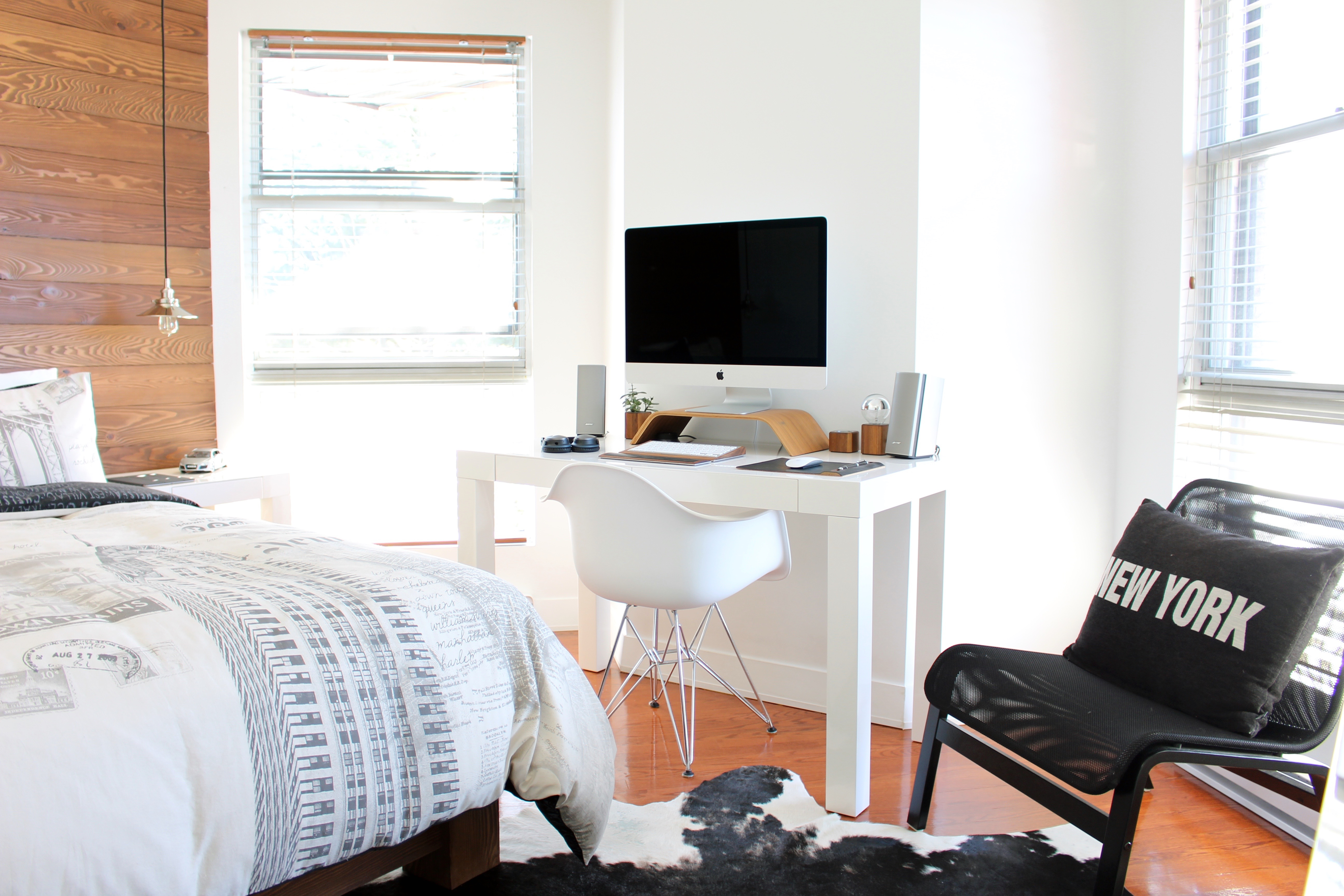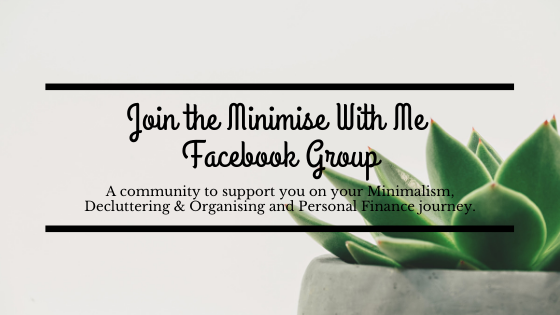There is nothing worse than walking into your bedroom after a long day at work and seeing piles of mess all over. Laundry on the floor, loose coins piled up on the bedside table, your quilt, and sheets on the floor – this used to be my daily visuals until I decided that I needed to have my bedroom as a place of calmness and tranquillity. Here are some bedroom organisation tips I’ve found, that helped me achieve a mess-free organised bedroom without too much effort.
Let’s jump right in and declutter with these 12 Simple Bedroom Organisation Tips to help you keep your bedroom the sanctuary you’ve always wanted it to be!
12 Simple Bedroom Organisation Tips
1. Make Your Bed Every Day
I’ve included this first on purpose. Always make your bed. It’s the first thing you will notice when you walk into your room and gives a sense of cleanliness and order at a glance. Even better it only takes a minute or less! Making your bed alone brings your bedroom up to a semi-tidiness level and will spark the desire to keep going and get the rest of the bedroom in order!
2. Remove Unnecessary Items and Declutter
Remove clutter or items that don’t belong in your bedroom. The key is to make sure everything has a home. If stuff from other rooms in the home seems to be creeping into your bedroom it’s time to remove it. An easy trick is to have baskets for each person in the household which you can return their items to ready to be put back in the appropriate room without having to take multiple trips.
Think about when was the last time you used each item in your bedroom. If it was more than 12 months ago, or something that doesn’t really bring you joy anymore, then let it go. A great way to facilitate decluttering things in your room as you go is to keep a donation box or basket in the bottom of your wardrobe so you can donate things as you go.
3. Keep Clothes Hampers Close By
Put a clothes hamper in your bedroom, bathroom, or wardrobe to keep laundry off the floor. Better yet, get one with compartments for sorting to save you time when it comes to laundry day. Mine is on a rolling frame with bags so you can roll the hamper to the laundry or just grab a bag and go!
Check out these 6 laundry hacks to keep you on top of your washing pile!
Declutter With Me Decluttering Course

Are you finding yourself overwhelmed and stressed out by clutter in your home? If you’re looking to minimise the excess in your life, Declutter With Me: A 12 Week Guide to Declutter Your Home is a go-at-your-own-pace course that will give you the step-by-step, room-by-room instructions to help you clear the clutter in your home in as soon as just 12 weeks!
But clearing the clutter isn’t just about getting rid of your excess stuff. It’s important to change your behaviour and consumer habits so you can avoid re-cluttering your space once you have decluttered. Included in Declutter With Me, are “Keep It Minimal” tips for each area in your home + 7 Tips To Help You Keep Your Home Minimal, to give you strategies you can implement to help you spend with intention so you can avoid bringing clutter back into your home.
If you are keen to minimise your unwanted clutter check out Declutter With Me so you can create a home you love!
4. Create a Capsule Wardrobe
In order to avoid the morning stress associated with having to pick something to wear from an overflowing wardrobe, and the resulting mess that comes from the mad rush, consider de-cluttering your wardrobe or creating a capsule wardrobe.
A more streamlined wardrobe filled with items you love will make getting ready a breeze and ensure those days of clothing strewn all over the floor are well behind you.

Related post: 7 Essential Questions to Help You Declutter Your Wardrobe!
5. Limit Items On Bedside Tables
Keep bedside table items to a minimum. It looks less cluttered and will be easier when it comes time to dust. Keep the things you need close by, such as the book you are currently reading but put the other stuff away. Ideally in your bedside table where they are accessible but not visually cluttering up your bedside table.
6. Organise Like Items together
Keep like items together; jewellery, hats, handbags, etc so they are easy to locate. And as an extra bonus, you can spend your money with intention as you can see what you have and know what you do and don’t need before going out shopping and coming home with duplicate items.
7. Utilise Over Door Hangers
Over-door-hangers are an easy storage option when you are lacking storage in your bedroom. The storage options for these are endless. You can use them to store things like shoes, socks, makeup, and jewellery.
Over-the-door hooks can be used to store clean but worn clothing so you can re-wear them. This will help keep clothes that can be worn again off the floor and provides great additional storage space and will keep your clothes lasting longer as you won’t be washing them every single time you wear them (within reason of course, please do wash your underwear after ease use hehe).
8. Keep the Floor Clear
Keep as little on the floor as possible. Open spaces do wonders for the appearance of tidiness. A hamper in the corner or cupboard will greatly help to achieve this! Place cushions back on your bed and fold any extra blankets.
9. Use the Kon-Mari Folding Method to Maximise Space
Fold your clothes Kon-Mari style. This method allows you to fit more in your drawers, reducing the number of drawers you will need which will help your room feel less cluttered. This folding method also allows you to see your clothes at a glance as they are ‘filed’ inside each drawer.
They will stay much tidier as you can pick what you want out at a glance, rather than having to dig through a vertical pile of clothes to find what you are after. This saves you having to refold everything constantly and allows you to easily close your drawers!
I made the change to folding using the Kon-Mari method years ago and will never go back.
Here is a video containing the instructions on how to fold clothing the Kon-Mari way if you are keen to see how it is done. Get ready to enjoy folding!
10. Be Selective With What You Bring Into Your Bedroom Space
Be selective with what you bring into your bedroom. Try to implement the one-in-one-out rule for clothing to avoid closet chaos. Don’t buy endless decorative items that take up space and attract dust. Select a few you love and keep the rest from cluttering up your room.
Check out these 7 questions to ask before buying anything to help you shop and spend your hard-earned money more intentionally.
11. Use Boxes, Baskets and Containers For Drawer Organisation
Use boxes like IKEA Skubb or DIY versions to organise drawers into sections. This can be great to organise bras, underwear, and socks or shirts into sections and keep them tidy and sectioned so they are easy to find. They also look great! And why not have beautifully organised spaces in drawers as well as elsewhere in your home!
12. Implement a Plan For Worn Clothing
One of the biggest pain points for untidy bedrooms is dealing with clothing and laundry, whether it be clean, worn but still wearable, or dirty.
Ensure every time you wear something you assess: Does this need to be washed or will I wear this again?
Find a system that works for you. Here’s mine.
I put dirty clothes immediately into a hamper in the bathroom and if it is something that can be worn a second time, I will hang it up on hooks behind our bathroom door.
Alternatively, you can put it back on a coat hanger in your closet or have a specific drawer for clothes you want to wear again but to keep them separate from the unworn clothes whilst keeping them off the floor.
Once you get into the habit of this, clothes left lying on the bedroom or bathroom floor – or wherever is your clothing hot spot in the house – will be a thing of the past and will go a long way to keeping your bedroom a tidy oasis!
I hope these will be some useful bedroom organisation tips for your household so you too can maintain a beautiful calming organised bedroom space.
Let me know in the comments what bedroom organisation tips you have for maintaining your bedroom!











